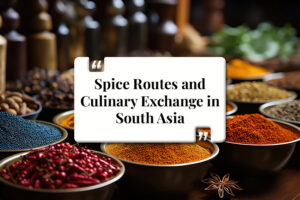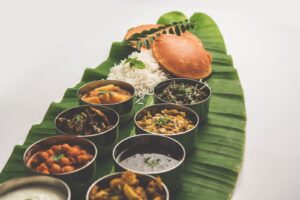Spices have been important to humans for a long time. They were not solely utilized for preparing food. They have evolved into key players in the realm of trade and commerce, shaping economies and influencing cultures around the world. From the dawn of civilization, spice routes were established as vital pathways connecting South Asia to distant lands, serving as the arteries through which valuable commodities like spices, herbs, and essential cooking ingredients were transported and exchanged. This across continents exchange of goods not only broadened the palates of diverse societies, but also fostered a sense of unity and mutual support through the shared appreciation of a wide range of flavors.
Through the annals of history, these historic spice routes have served as conduits of not only culinary exchange, but also of cultural diffusion and mutual enrichment among societies spanning vast distances. As we embark on a journey through time along these fabled pathways, we are transported to a world teeming with an astonishing variety of tastes and aromas introduced by spices like cinnamon, pepper, and cardamom. These exotic flavors, once considered rare and precious commodities, have now become ubiquitous in kitchens across the globe, enriching dishes with their distinctive profiles and enhancing culinary experiences for countless individuals.
Routes and Culinary Exchange In South Asia
As we delve deeper into the origins and impact of these revered spices, we come to appreciate the profound influence they have wielded in shaping the global culinary landscape. Their journey from distant lands to our plates has not only added depth and complexity to our cuisine, but has also forged connections between peoples and cultures, creating a tapestry of flavors that reflect the shared heritage of mankind. Join us on a voyage of discovery as we unravel the rich tapestry of history woven by these aromatic treasures, and gain a deeper understanding of their enduring legacy in the world of food and trade.
Spices Routes In South Asia
Throughout the annals of culinary history, spices have held a position of immense importance in shaping the trajectory of human society, transcending their initial use as flavor enhancers to become integral components of global trade and economic systems. Stretching back to ancient times, the establishment of intricate spice routes forged a crucial network linking the regions of South Asian with far-flung territories, acting as the vital conduits through which valuable commodities like spices, herbs, and various cooking ingredients were transported and exchanged. This cross-cultural interchange not only broadened the gastronomic horizons of diverse societies, but also served to foster a sense of unity and mutual appreciation through the shared enjoyment of a diverse array of flavors.
As we delve into the pages ahead, we extend an invitation to you to embark on a captivating gastronomic adventure along the time-honored spice routes, unravelling the intricate tapestry of tastes brought forth by renowned spices including cinnamon, pepper, and cardamom, and gaining insight into the profound impact they have wielded in shaping the culinary landscape on a global scale.
The Spices Route
The spice routes were a labyrinth of interconnected trade paths that spanned the continents of Asia, Africa, and Europe, serving as a crucial conduit for commerce and communication in the ancient world. These extensive trade routes were not limited to the exchange of spices and herbs but also made easier the transportation of a diverse range of luxurious goods, including textiles, silk, tea, and porcelain. Within this vast network of trade routes, the Silk Road emerged as a key player, bridging the gap between the powerful Chinese empire and the bustling ports of the Mediterranean.
This historic route played a significant role in the exchange of commodities and ideas between Eastern and Western civilizations. However, it is important to note that while the Silk Road often steals the spotlight, the spice routes were equally essential in transporting sought-after spices like cinnamon, pepper, and cardamom from their places of origin to markets in faraway lands. The spice routes played a pivotal role in enriching cultures and economies along their paths, leaving a lasting impact on the ancient world.
The Importance of Spices
Spices have held a significant place in human history, dating back to ancient times. They were not only appreciated for their exquisite flavors. But also revered for their healing properties that were believed to contribute to overall well-being. Apart from their culinary uses, spices played a crucial role in food preservation. It is helping to extend the shelf life of perishable items. Furthermore, spices were utilized to mask any undesirable tastes in dishes and elevate the complexity of flavors. Additionally, these precious commodities symbolized affluence and authority. Due to their scarcity and high cost, prompting the establishment of a thriving spice trade network. That involved extensive travel by merchants and traders in order to acquire and distribute these coveted goods.
In antiquity, spices were more than just condiments. They held an esteemed status in various cultures for their perceived medicinal virtues. Not only were they utilized to enhance the taste of food. But they were also believed to possess healing properties. That could alleviate ailments and promote good health. Moreover, spices served a practical function as well, being employed in food preservation techniques to prevent spoilage and extend the edibility of meals. While providing a delightful sensory experience, spices were also considered a symbol of opulence and influence. Due to their scarcity and premium price point. As a result, a flourishing global trade in spices emerged, with merchants and traders embarking on perilous journeys across vast distances. To procure and trade these highly sought-after commodities.
Cinnamon: The Queen of Spices
Cinnamon, a spice with origins dating back to ancient times. It has long been held in high regard among various cultures across the globe. Its unique and delightful sweet flavor, paired with its warm aroma. It has made it a popular choice for enhancing the taste of a wide variety of culinary dishes. From indulgent desserts to hearty stews, cinnamon has been a key ingredient in countless recipes throughout history. Beyond its culinary applications, cinnamon was also valued for its potential medicinal properties.
Ancient healers believed in the healing powers of cinnamon and used it to treat a diverse range of ailments. Such was the importance of cinnamon that it was even used as a form of currency in trade transactions. Highlighting its value and significance in society. In a fascinating display of cultural reverence. The ancient Egyptians added cinnamon into their embalming processes. Showcasing the deep respect and admiration they held for this versatile spice.
Pepper: The King of Spices
Pepper, a spice that was highly coveted in the ancient world. It is held great significance in culinary practices. As it was utilized not only to enhance the taste and heat of dishes but also to provide potential medicinal benefits. This versatile spice was not only a flavorful addition to meals but also held considerable value. Earning it the moniker of “black gold.” So esteemed was pepper that in certain regions. It served as a form of currency. Further accentuating its importance and attractiveness. The immense demand for pepper spurred expeditions and the colonization of previously unknown lands. Such as India and the Americas, in pursuit of securing and controlling the lucrative spice trade.
Pepper, an ancient spice that held a prominent place in the world of culinary arts. It was highly esteemed for its ability to infuse dishes with both heat and flavor. Along with the perceived medicinal properties it was believed to possess. This spice, which was commonly referred to as “black gold” due to its exceptional value, was not merely a culinary ingredient. But also symbolized wealth and prosperity, with its scarcity and desirability making it a highly sought-after commodity. Its significance was such that in certain regions. It was used as a form of currency, underscoring its importance in trade and commerce. The insatiable demand for pepper prompted extensive voyages of discovery and colonization efforts. In search of new territories. Such as India and the Americas, to secure and monopolize the lucrative spice trade.
More About Pepper (Spices)
Pepper, an immensely prized spice from ancient times. Held a crucial role in the culinary world for its dual function of imparting heat and flavor to various dishes. As well as being ascribed medicinal properties in certain cultural beliefs. The exceptional value attached to pepper earned it the title of “black gold,” signifying its status as a valuable commodity. That was highly sought after and held in high regard. This spice was so highly esteemed that in specific regions. It served as a medium of exchange, highlighting its importance as a form of currency in trade and transactions. The soaring demand for pepper not only influenced economic dynamics. But also fueled exploratory endeavors and colonization efforts that led to the discovery and cultivation of new territories. Such as India and the Americas, in a bid to dominate the lucrative spice market.
Cardamom: The Queen of Spices
Cardamom, a spice that has been highly sought after and prized by civilizations for centuries. It has a rich and intriguing history that can be traced back to ancient times. This aromatic spice is not only known for its unique ability to enhance the flavor profile of dishes with its sweet and floral notes. But it has also become a staple in the kitchens of chefs and home cooks around the world. However, the allure of cardamom extends beyond its culinary uses. As it was revered for its believed medicinal properties that added to its mystique and desirability.
Interestingly, cardamom was so highly esteemed. That it was often used as a form of currency in trade transactions, highlighting. Its significant role in the global market. Moreover, in ancient Egypt, cardamom served a dual purpose as both a spice for culinary endeavors and a key ingredient. In the creation of perfumes and incense, demonstrating its variety and adaptability in various cultural practices and rituals.
Global Flavors Of Spices
The ancient spice routes were instrumental in transforming not only the culinary landscape. But also in influencing cultural and social practices worldwide. With the introduction of an array of new and exotic spices from far-off lands. Moreover, a gastronomic revolution took place, giving birth to a multitude of unique and varied dishes in different culinary traditions.
The adding of spices in cooking not only served to enhance the flavors of food. But it also became a significant symbol of wealth and social status. With prized spices fetching exorbitant prices in markets across the globe. This surge in demand for spices spurred the establishment of new trade routes and prompted explorations of uncharted territories. Leaving an indelible mark on history. Presently, the enduring legacy of these ancient spice routes can be witnessed in the diverse array of global flavors and cuisines enjoyed by people worldwide. Underscoring the profound and lasting impact of these culinary exchanges.
Read More: Best Indian Food in Dallas
Conclusion
It is quite evident that the ancient spice routes, which date back centuries ago, have had a profound and enduring impact on the culinary world as we know it today. These historic routes served as vital pathways for the exchange of various spices, herbs, and other culinary ingredients among diverse cultures from distant corners of the globe. This culinary exchange, facilitated by the spice routes, effectively brought together a plethora of flavors and ingredients that melded and intertwined to create a melting pot of diverse culinary traditions and practices.
As a result, the culinary landscape was forever transformed. With the influence of spices such as cinnamon, pepper, and cardamom being particularly noteworthy. Due to their unique and exotic flavors that captivated the palates of many. These luxurious and highly prized spices soon became symbols of wealth and social status in numerous societies. Further adding to their allure and significance. Fast forward to the present day, and it is undeniable. That these ancient spices continue to play a crucial role in shaping the flavors and aromas of countless traditional dishes enjoyed across the globe. Next time you use cinnamon or pepper in your cooking. Think about their long history and importance in our food traditions. These spices have become a crucial part of how we cook and eat over time.









